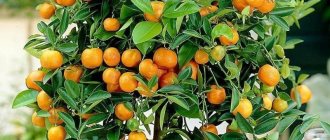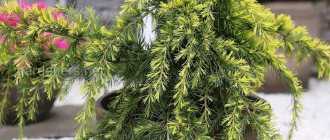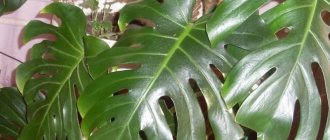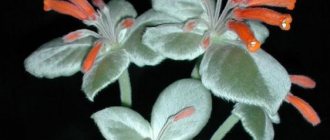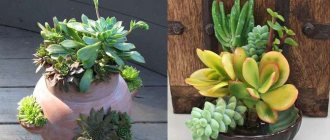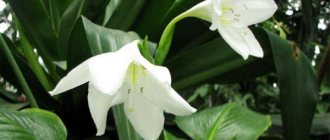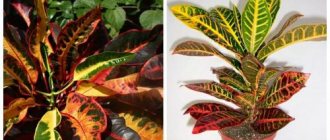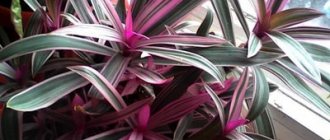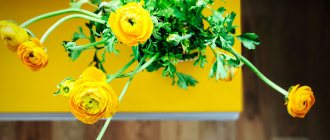Indoor plants are extremely useful; not only do they improve the microclimate of the room where they grow, but they also have a beneficial effect on a person’s mood and emotional state. And the expression “the more the better” can be applied to them. Large indoor plants and flowers can decorate any room: rooms in an apartment, office, etc. They add volume, life, and greenery to the space. To choose the most suitable option, it is useful to know what kind of large-sized plants there are. And a detailed catalog with photographs and name should help with this.
Catalog of large indoor plants with photos and names
Overall giants leave few people indifferent. Thanks to the majestic and massive beauty of large plants, you can create real oases in your rooms.
Nephrolepis
Nephrolepis boasts an abundance of lush, airy greenery and its unpretentiousness. Indoor fern grows up to 60-80 cm. Very beautiful as an hanging plant.
By the way, it is believed that it purifies the air. Ferns are shade-loving plants, but nephrolepis requires diffuse sunlight. Indoor ferns also require high humidity.
Zamioculcas
Zamioculcas is popularly called the “Dollar Tree”. The exotic Zamioculcas is very unpretentious and visually impressive (largely due to its fleshy leaves). Ideal for lovers of large sizes.
At home it can grow up to 1-1.5 meters. However, it is important to know that the dollar tree is a slow-growing potted plant. Prefers bright places in the house with diffused light.
Dracaena fragrant
The largest type of dracaena is the fragrant dracaena, so those who like large dimensions should plant it.
She is unpretentious and easy to care for. Beautiful glossy long leaves. High air humidity is important for it. Capable of growing up to 2 meters.
Beaucarnea (Nolina)
The second name of bocarnea is Nolina. Due to the thick trunk at the base, it looks like a bottle, which is why it is also called the “bottle tree.” Valued for its extraordinary, exotic appearance: interesting trunk, long, narrow leaves, corky bark.
The most popular type that can be found on sale with us: Nolina bent, maximum height is about 150 cm. Bokarney needs bright diffused light.
Araucaria variegated (Indoor spruce)
Ephedra is characterized by slow growth. Outwardly very similar to a miniature spruce. Charming with its beautiful soft needle-like leaves. Araucaria variegated is one of the few conifers cultivated as a houseplant. Height at home up to 1.5 m.
Araucaria is believed to purify the air. When grown, it does not like high temperatures; in winter it should not be more than +14-16°C. Prefers bright, diffused light, but it is recommended to shade the home spruce from direct rays.
Cypress
Cypress is another rare representative of conifers that can be grown at home. Height is about 50-60 cm.
The place where the cypress tree grows should be without direct sunlight, it can even be shady. In winter, t should not be more than 12-15 degrees.
Lemon
Many people love the delicious fruits of lemon. However, you can not only eat its fruits, but also grow exotic fruits with your own hands. Reaches a height of about 1.5 m.
Loves high-quality lighting, but should be shaded at midday. Lemon prefers moist air (spraying from a spray bottle, special humidifiers). With proper care, you can easily grow fruits.
Calamondin (Citrofortunella)
Since we are talking about citrus fruits, it is worth noting that calamondin can also be grown at home. Another popular name for calamondin is Citrofortunella.
It has a beautiful neat crown and bright fruits. The evergreen tree in indoor conditions reaches a maximum of 2 meters.
Hoya (Wax Ivy)
The second name of the tropical vine is Wax Ivy (because the dense leaves have a waxy coating). The most popular species grown at home is Hoya fleshy (or Hoya waxy).
Hoya can be safely called an unpretentious and easy-to-care exotic. At home, the length of a beautifully flowering vine is no more than 5-6 meters.
Hedera (Indoor ivy)
Hedera is large in size, not in height, but in width. Long shoots can grow up to 3-6 m. Common ivy or climbing ivy is often planted in culture. Hedera is most often grown as an ampel plant in hanging pots.
Indoor ivy is easy to care for and very hardy, resistant to low temperatures, drought, and lack of light. It is valued not only for its decorative properties: it helps purify the air. Lighting depends on the color: for varieties with variegated leaves, bright diffused lighting is needed, for green ones - partial shade or shade. Prefers moist air.
Fatsia
Fatsia (its other names are “Japanese chestnut”, “House chestnut”) is capable of growing up to 1-1.5 m. Japanese chestnut has spectacular large palmate leaves.
Fatsia has enviable durability, ease of care and shade tolerance (it can be placed in locations with any illumination, except, perhaps, places that receive direct sunlight at midday).
Cycas (cycad, sago palm)
Cycas (or Cycad, Sago palm) is interesting for its appearance: a thick trunk, beautiful lush carved leaves. The cycad looks like a palm tree, but is not one.
Cycas needs diffused bright light or partial shade, and high humidity in the room. It grows slowly, so if you want to grow a large cycas, you will have to be patient. The maximum height of a cycad indoors is 50-80 cm.
Yucca ivory (Giant)
Yucca ivory or Yucca gigantea looks interesting, impressive and exotic: a powerful trunk, bunches of hard sword-shaped leaves. Pseudopalm grows slowly, up to 2 m in height. Yucca improves air quality by purifying it.
Light-loving yucca should be placed in a sunny place or under diffused light. However, young specimens must be protected from direct sunlight at midday. Tolerates drafts and temperature changes painfully.
What is special about these flowers?
Yellow indoor plants have many fans. And this is no coincidence, because these flowers have a number of advantages over others:
- bright sunny colors make the atmosphere of the house solemn;
- improve the well-being and lift the mood of the owners;
- Most of these plants have not only brightly colored flowers, but also beautiful leaves.
In addition to the listed advantages, yellow flowers also have all the properties of other indoor plants. They humidify the air, saturate it with oxygen, protect against electromagnetic radiation and some viruses.
Interesting! According to folk superstitions, flowers with yellow petals protect the hearth, help maintain love and harmony in the family, and bring wealth.
List of indoor plants with large leaves
Plants and flowers with large leaves significantly transform the room, making it more “natural” and green. They give the impression that a person is in the tropics. Potted plants or flowers with large leaves can be tall or medium or low in height. Let's look at which of them can be grown.
Monstera attractive (delicacy)
Monstera attractive (or M. deliciosa) is a tropical vine that is loved by many for its huge dense leaves with graceful slits. It is characterized by fast growth and undemanding, hardy.
At home, it can grow up to 2-3 meters, but the length of the leaves is about 30-35 cm. It is best to place the monstera pot under diffused lighting. Monstera needs support.
Sansevieria
Without a doubt, Sansevieria can be called one of the most unpretentious indoor plants. The most popular species: Sansevieria three-lane (varieties also grown: S. cylindrical, S. Hana). The height of sansevieria is formed due to long leaves (up to 100-120 cm in length, about 7 cm in width), but it does not have a separate trunk.
She was loved by many for her long leaves of a strict and laconic shape. Therefore, if you want to decorate your home or office with a large plant that is pleasant to the eye, but you do not have the opportunity to regularly provide it with careful care, then it is advisable to choose sansevieria. It also purifies room air and enriches it with oxygen.
Ficus rubber (Elastica)
Ficus rubber (or F. elastica, F. elastica) is one of the most popular and unpretentious decorative foliage plants. It is popular due to its large, showy, leathery, dark green leaves and ease of care. It also purifies the air and saturates it with oxygen.
Ficus rubber is comfortable in diffused light or light partial shade, as well as high air humidity. In culture, its height, as a rule, does not exceed 2-3 meters. Dimensions of large leaves: 20-30 cm long, about 10-20 cm wide.
Important! Ficus rubber sap contains toxic substances, so be careful when working with it.
Aspidistra
Aspidistra is deservedly considered one of the most hardy and undemanding ornamental plants. It is shade-tolerant, does not require special care and can delight with its decorative effect for a long time. The beautiful and spectacular shape of the glossy leaves is mesmerizing.
The height of the aspidistra is determined by the length of the leaves, usually up to 0.8 m. Any lighting except direct sun is suitable for it.
Dieffenbachia
The most popular type: Dieffenbachia spotted (or painted). Large, wide leaves often have a pattern (spots, stripes, inclusions, veins), and their length is about 60 cm, width 40 cm.
The height of an adult Dieffenbachia is up to 2 m. It responds well to high-quality diffuse lighting.
Note! Dieffenbachia juice is poisonous. Therefore, take care of it with care. It is also better to refrain from planting if there is a possibility of contact between Dieffenbachia and children/pets.
Anthurium Andre (Men's happiness)
Anthurium Andre (second name Male Happiness) boasts beautiful glossy dense leaves of rich green color (their length is up to 40 cm, width is approximately 20 cm). Height up to 1 meter. Anthurium also has an interesting flowering pattern: a cob-shaped flower with a beautiful blanket of white, red, and pink shades.
The flowering plant must be grown in a room with high humidity. Diffused light is suitable, it is also shade-tolerant and can withstand partial shade. Requires heat, does not tolerate drafts and temperature changes.
Aglaonema
Lush, luxurious and patterned leaves forming a lush bush are the calling card of aglaonema. The color can be of 2 or 3 colors. A variegated color (yellow, silver, white, pink, etc.) can appear as elegant spots, dots, streaks, and borders. Leaf dimensions: length up to 30 cm, width 5-10 cm. But the height of the bush is up to 70 cm.
Aglaonema is a rather capricious decorative foliage potted plant. It needs regular care, high humidity, and should be grown in partial shade.
Important! Aglaonema is poisonous! Be careful!
Strelizia
Strelitzia (or Strelitzia) is an undemanding and unpretentious exotic flowering plant that grows up to 0.9-1.5 m. It prefers a location with diffused light without direct rays. Feels normal at high air humidity.
Strelitzia will definitely add bright accents to the interior, because it has large leaves (from 0.3 to 1.5 m long, 10-80 cm wide) and colorful flowering. By the way, the bright orange flower resembles the crest of a bird (as can be clearly seen in the photo below). It’s not for nothing that Strelitzia’s second name is “Bird of Paradise.” At the same time, it blooms for a long time.
Croton (Codiaeum)
Croton (second name Codiaum) is a very decorative and beautiful decorative foliage plant. It is loved by many thanks to its leaves: glossy and variegated, with pronounced veins, and a variety of colors. The color can be green, orange, red, pink. The height of the codiaum is about 40-70 cm. The length of the leaves is about 30 cm.
Croton is very demanding in terms of growing and care conditions, so when purchasing it, be prepared in advance to take careful care of it! Codiaum needs bright diffused light (or bright light, but at noon - shading from direct rays) and high humidity in the room. Does not tolerate drafts.
Note! Croton sap is poisonous, so when caring for codieus, you need to handle it carefully! It is also not recommended to grow it if there are children or pets in the room.
Clivia orange
This flower belongs to the amaryllis family and differs from plants of the same species in the absence of bulbs: clivia has a massive rhizome. Orange inflorescences look very impressive against the background of tongue-shaped leaves of dark green color.
Clivia is unique in that it can bloom in winter, when other plants have a dormant period. Bright orange, odorless flowers stand out against the background of an enlarged stem, the height of which is 50-100 cm.
Treatment for Clevia includes:
- moderate watering;
- temperature regime - from 18 to 26 ° C;
- humidity - up to 80%;
- the lighting is bright but dim;
- location on the north or east side.
Attention! It is not recommended to spray clivia; it is enough to maintain the required level of humidity in the room.
The tallest indoor (long) plants and flowers
Tall indoor decorative foliage plants and flowers with their volumes can decorate large locations in the room (from floor to ceiling). They look especially interesting in spacious living rooms, halls, and office spaces. Below is a list of the most spectacular tall and long plants with photographs and names.
Ficus benjamina
ficus benjamina is quite popular in our country. He is very unpretentious and undemanding. The maximum height of Ficus Benjamin indoors is 2-3 meters.
Prefers high air humidity and good lighting with shading during hours of maximum solar activity.
Indoor hibiscus (Chinese rose)
Indoor hibiscus or Chinese rose is a lush and colorful flowering plant. The Chinese rose grows quickly. Hibiscus can reach up to 2-3 meters in height. Variegated inflorescences of pink, red, white, yellow, orange, purple. There are even two-color varieties. Flower diameter is about 10 cm.
In general, it is quite unpretentious, but it needs to be looked after in a timely manner. This moisture-loving plant requires watering, is afraid of drafts, and prefers bright, diffused light.
Palm trees
All of the palm trees listed below love good light, but in the summer they should be protected from direct sunlight at midday. They should not be placed in the shade! It is advisable to regularly turn it in different directions towards the light.
Advice! Palm trees need high air humidity, especially in winter (you can spray them with a spray bottle, or turn on a humidifier).
So, here are the long palm trees you can grow:
Hovea
Howea is a very beautiful, hardy, unpretentious palm tree that will delight the eye with its size and pleasant appearance for many years. Grows up to 2-3.5 meters. Two species are grown in culture: Howea Forster and Howea Belmora.
Date palm
The date palm is spectacular: tall, long carved leaves with narrow feathers. It is distinguished by its unpretentiousness, endurance, and undemandingness to growing conditions. Exotic reaches a height of 1.5-2 m.
Washingtonia
Washingtonia is another spectacular and tall representative of indoor palm trees. Beautiful fan-shaped leaves. Washingtonia is a fast-growing palm tree that can reach a height of about 3 meters.
Liviston Palm
The Liviston palm tree is not inferior in beauty and effectiveness to its relatives. The temperature is desirable to be moderate, in winter no more than 16 degrees. Grows up to 1.5-2 m.
Hamedorea gracilis
Hamedorea graceful or X. Elegans is very unpretentious and easy to care for. Hard, feathery leaves give it an airy and exotic feel. Height up to 1.5-2 m. Hamedorea is able to purify the air by absorbing harmful impurities.
Dipsis yellowish (Chrysalidocarpus, areca palm)
Dipsis (other names: yellowish Chrysalidocarpus, areca palm) its name literally translates as “golden butterfly”. The beautiful name fully corresponds to the luxurious shell. The tall chrysalidocarpus is a multi-stemmed palm; up to twenty offspring can grow from the mother stem. The length of the dipsis stem is up to 1-2.5 m.
Care
Although reo is not a capricious flower, it is very responsive to good care . If you take care of it according to all the rules, reo can become a real decoration for your home flower collection.
Light and temperature
Reo requires good lighting, but direct sunlight can be detrimental to it . The best choice is windows facing west and east.
If you place the reo plant on a southern windowsill, your green pet will need light shading. On northern windows, lighting may be required, because if the flower does not have enough light, its stems will begin to stretch.
ATTENTION : lack of light negatively affects the decorative properties of reo.
This plant should not be exposed to sudden temperature changes . We must try to maintain the air temperature around 20 degrees in summer and at least 15 in winter.
Watering
The amount of watering is adjusted depending on the season:
- from spring to autumn - intense,
- in winter – moderate.
The same approach can be applied to spraying - such water procedures are extremely pleasant for the plant, however, in the cold season they should be carried out less frequently, but not completely eliminated, since due to the operation of heating radiators in the room there is quite low air humidity.
Reo is a moisture-loving crop, so the soil in the pot should always remain moist.
And so that the roots do not suffer from excess moisture, you need to ensure high-quality drainage in advance.
A good option for increasing humidity levels is to place pots on trays filled with wet moss or pebbles.
By regularly adding water to the tray, you will be able to maintain the moisture level required by the plant. The water should be at room temperature and soft in composition. After half an hour or an hour, the water needs to be poured out of the pan.
Fertilizers and fertilizers
Reo needs fertilizers and fertilizing from the first month of spring to August inclusive. They need to be done once every two weeks. In autumn, the number of fertilizing is reduced, in winter - they are stopped completely.
The fact is that in a state of relative dormancy, the plant consumes less nutrients and they begin to accumulate in the soil, which can subsequently have a negative effect on the flower.
It is advisable to use complex mineral fertilizers, as well as organic fertilizers, strictly in accordance with the volumes specified in the instructions.
Experts warn: a plant can more easily tolerate a lack of fertilizer than an excess amount.
Transfer
Adult specimens do not require frequent replanting; it is enough to do it once every 3-4 years . With “youth” this procedure is carried out every spring, usually using the transshipment method. First, the top layer of “old” soil, in which there are no longer any nutrients left, is removed.
Each time the pot is taken a little larger than the previous one , and the shape is always chosen the same - with a large diameter and insignificant depth. The fact is that the rheo root system grows more actively in width than in length. Drainage must be laid at the bottom. For more information about rheo transplantation, watch this video:
Advantages and disadvantages of growing large plants
Large-sized plants are popular at home and in other spaces (offices, schools, hospitals) because they are versatile and suitable for various interiors.
Benefits of growing large plants:
- They allow you to significantly green the room.
- Improves the microclimate of the home.
- They make a room or other space more beautiful and aesthetically pleasing. Very often they only emphasize the beauty of the interior.
- They help hide defects or imperfections in cosmetic repairs.
- One or several large specimens will serve as an alternative to numerous small pots on window sills. Moreover, they can be placed both on the window and on the floor spaces.
- As a rule, large-sized houseplants are hardier and less demanding. However, it should be remembered that this is not always the case; there are also very capricious “giants”.
Disadvantages of growing tall plants or specimens with large leaves:
- The very first and main drawback: they take up a lot of space in the room. And if there is already too much furniture and interior items in the house/office, then you will have to rack your brains about where to correctly “squeeze” your green friend or choose more compact sizes. Therefore, they are not suitable for cramped housing.
- It is necessary to find a place in the house or other room where they will feel calm.
- Plants that are too voluminous or tall can interfere with their size. For example, they interfere with free movement in space, moving some pieces of furniture or interior design.
- If the ceiling in the room is too low, then the tallest species may be limited in growth, which will affect their decorativeness and even possibly their health.
Tips for choosing large sizes
A few tips will help you choose the most suitable “green” large size:
- Find out in advance how quickly a particular plant grows. After all, some of them reach large dimensions only after a few years.
- If you want to get significant sizes quickly, then it is better to buy an already mature specimen or choose fast-growing species.
- Before purchasing, think in advance about where it is best to place your green friend, and whether the chosen location meets the necessary conditions (lighting, air humidity, etc.). It is important that this or that plant is in the most suitable environment for it.
- If you choose a plant with a large height, then you need to place it in a room with appropriate ceilings.
Some care tips:
- Some specimens require additional support in the pot.
- Initially, you need to plant it in the right pot, suitable in size (height, width, diameter), with drainage holes. In a small pot, the root system will not be able to develop normally, and in a pot that is too large, water may stagnate in the soil.
- To protect the plant from stress, it is advisable that it stands in one place throughout its entire life.
Thanks to the relatively large selection, you can choose the most suitable potted plant for your room or office. The choice may fall on either a flowering specimen, or a decorative deciduous variety with large or fleshy leaves, or a tall one. Remember, in order for a large plant to delight you with its decorative properties for a long time, it is necessary to take good care of its potted “friend”.
Hypocyrtha flower naked
The plant belongs to the ampelous family and has flowers of various shades of orange. Hypochirta has an enlarged stem with dark green, oval-shaped leaves. The plant reaches a height of 50 cm. Owners of hypocyrts can observe its flowering every spring.
Necessary growth conditions:
- frequent abundant watering;
- air humidity - up to 85%;
- bright lighting;
- location on the east or west side.
Interesting! With proper hypocyrtus care, exposed skin can thrive again.
